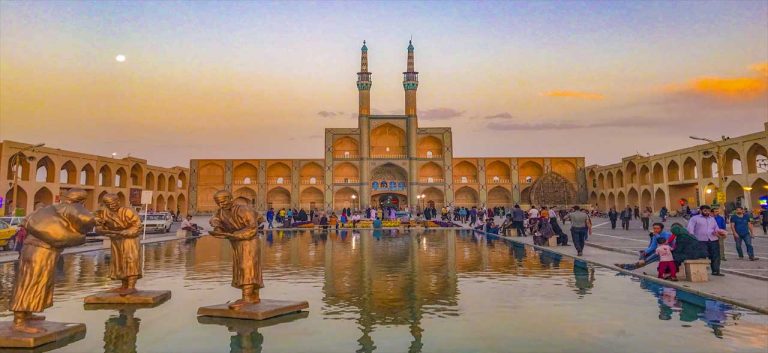Narin Qaleh (in Meybod)
Ice House (in Meybod)
Shah Abbasi Caravansary (in Meybod)
Pigging House (in Meybod)
Chapar Khaneh (in Meybod)
Chack Chak (near Ardakan)
Kharanaq Village

 Yazd city a Desert Jewel with Rich History and Unique Architecture.
Yazd city a Desert Jewel with Rich History and Unique Architecture.
A magnificent deserted city located in central Iran between Kerman and Isfahan and considered one of the most visited cities of the country.
Yazd has a rich history and unique architecture that is recognized as a UNESCO World Heritage Site. It is also known for its stunning desert landscape, wind catchers, and ancient buildings, is a must-visit for anyone interested in Persian culture and history.
During the (226-642 A.D) Sassanid dynasty, Yazd was an important center for the followers of the Zoroastrian faith and it is continued up to the present and now the largest Iranian Zoroastrian community is still living here.
The fire temple of Yazd city which houses a sacred flame that has been burning for over 1,500 years and Chak Chak village are the most sacred places and pilgrimage sites for Zoroastrians from all around the world.
People in this area are adopted living in the desert and during the centuries they discover how to live in this situation.
Yazd has been inhabited for over 5,000 years, and its historical parts are a testament to its rich cultural heritage.
The city’s old town is a maze of narrow alleys and traditional mud-brick buildings that date back to the 14th century. The ancient buildings are well-preserved and showcase the city’s unique architecture that is designed to withstand the harsh desert climate.
The best time to visit Yazd city is during spring (April to June) and autumn (September to November) when the temperatures are mild and pleasant.
Summers can be quite hot, with temperatures soaring above 40°C (104°F) during the day, making it uncomfortable for outdoor activities.
Winter, on the other hand, can be cold with occasional snowfalls, making it challenging to explore the city’s outdoor attractions.
Marco polo the famous Italian merchant and explorer mentioned Yazd as a noble city that people weave special silk tissue when he passed through Asia along the Silk road.
The most common material for building houses is mud-brick which acts as insulation to prevent heat, however, the design of these houses is incredibly beautiful and amazing.
Traveling to Yazd will teach you how people live in a desert town and how they adapt to it, In addition to visiting unique and ancient attractions that every traveler should see during his trip to Iran
You will learn the mechanism of underground water supplement that is called Qanat, water reservoirs (Ab Anbar), icehouses (Traditional refrigerator), wind catchers (Air conditioning system), and pigeon towers (Used as a natural fertilizer for fields and farms).
Yazd is a unique destination that offers visitors a glimpse into Iran’s rich cultural heritage. With its ancient buildings, stunning desert landscape, and unique architecture, the city is a must-visit for anyone interested in Persian culture and history.
Whether you are interested in exploring the city’s historical sites, learning about the ancient water management system, or simply enjoying the stunning desert scenery, Yazd has something for everyone. So, plan your trip to Yazd, and experience the magic of this desert jewel.
Jame Mosque
Amirchaqmaq Square
Dowlatabad Garden
Varahram Fire Temple
Towers of Silence
Water Museum
Alexander/Harun Prison (Ziyaeieh School)
Fahadan Residential Quarter
Boqeh Davazdeh Imam (12 Shia Imams Holy place)
Lariha House
Narin Qaleh (in Meybod)
Ice House (in Meybod)
Shah Abbasi Caravansary (in Meybod)
Pigging House (in Meybod)
Chapar Khaneh (in Meybod)
Chack Chak (near Ardakan)
Kharanaq Village
Carpet Weaving
Pileless carpets
Termeh (traditional Brocade)
Brocaded Silk
Velvet
Blankets
Bed-clothes
Earthenware
Engraving
Glassware
Leatherware
Yazdi Gheime
Baghlava
Qutab
Pashmak
Paloode Yazdi